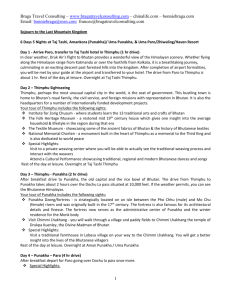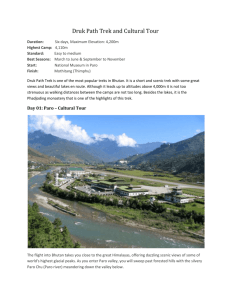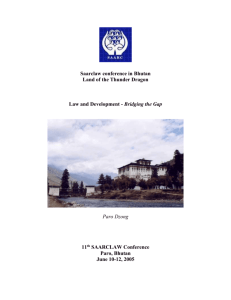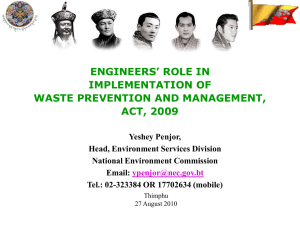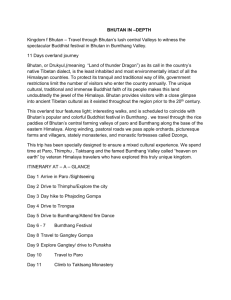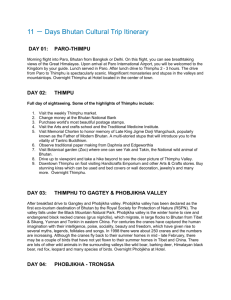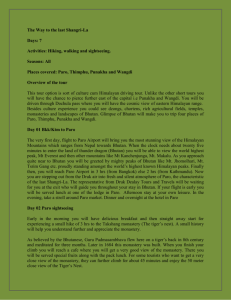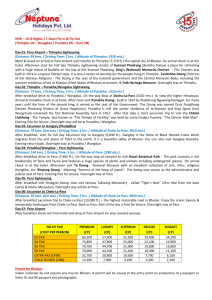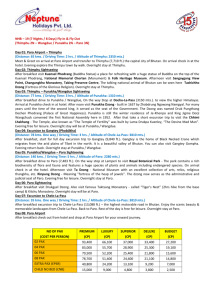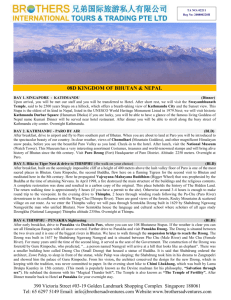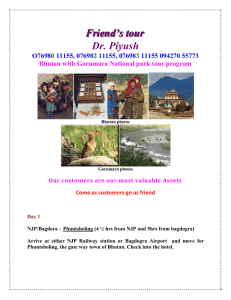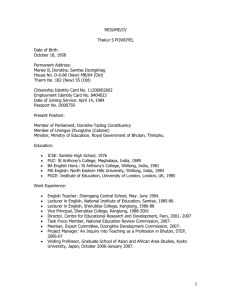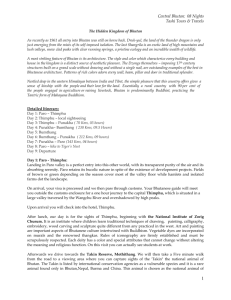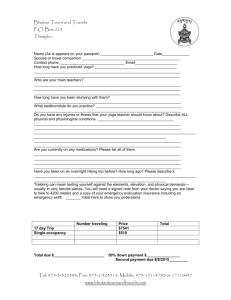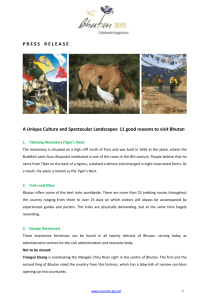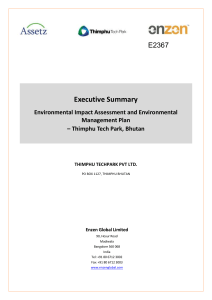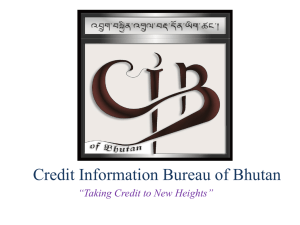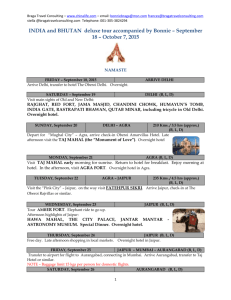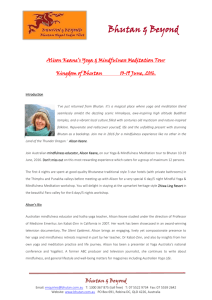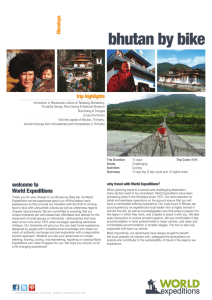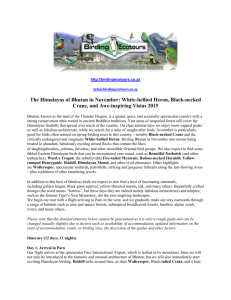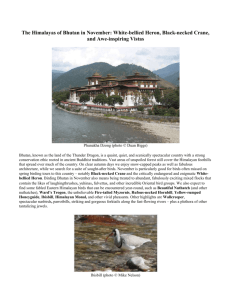Bhutan Thimphu Tshechu - Bhutan Majestic Travel
advertisement
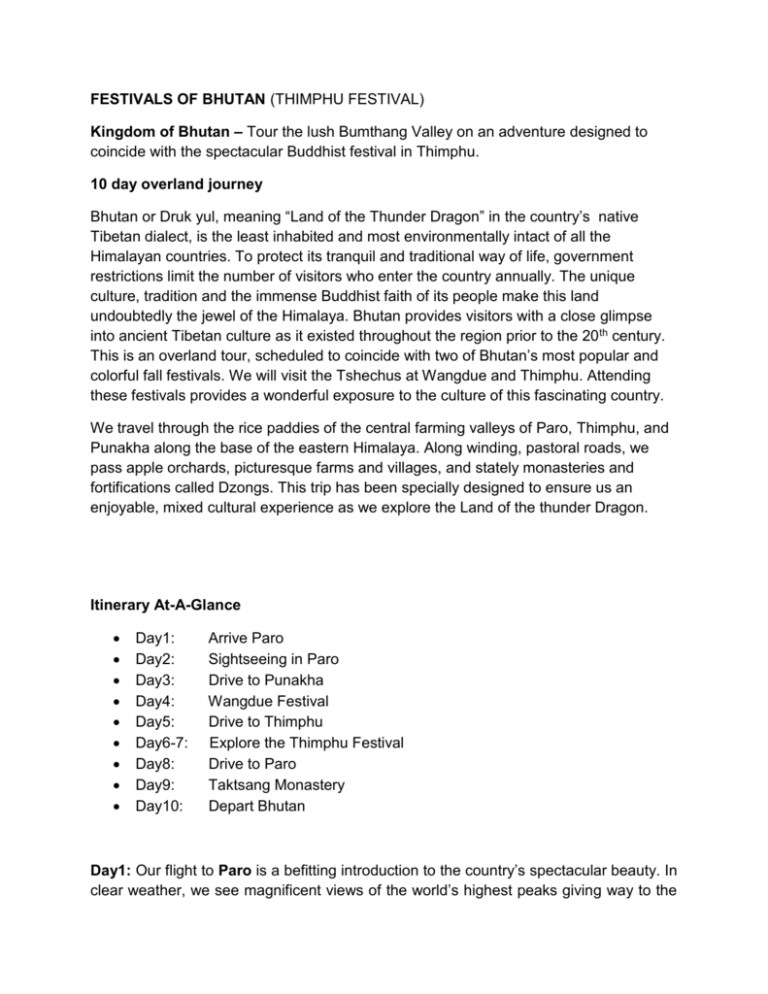
FESTIVALS OF BHUTAN (THIMPHU FESTIVAL) Kingdom of Bhutan – Tour the lush Bumthang Valley on an adventure designed to coincide with the spectacular Buddhist festival in Thimphu. 10 day overland journey Bhutan or Druk yul, meaning “Land of the Thunder Dragon” in the country’s native Tibetan dialect, is the least inhabited and most environmentally intact of all the Himalayan countries. To protect its tranquil and traditional way of life, government restrictions limit the number of visitors who enter the country annually. The unique culture, tradition and the immense Buddhist faith of its people make this land undoubtedly the jewel of the Himalaya. Bhutan provides visitors with a close glimpse into ancient Tibetan culture as it existed throughout the region prior to the 20 th century. This is an overland tour, scheduled to coincide with two of Bhutan’s most popular and colorful fall festivals. We will visit the Tshechus at Wangdue and Thimphu. Attending these festivals provides a wonderful exposure to the culture of this fascinating country. We travel through the rice paddies of the central farming valleys of Paro, Thimphu, and Punakha along the base of the eastern Himalaya. Along winding, pastoral roads, we pass apple orchards, picturesque farms and villages, and stately monasteries and fortifications called Dzongs. This trip has been specially designed to ensure us an enjoyable, mixed cultural experience as we explore the Land of the thunder Dragon. Itinerary At-A-Glance Day1: Day2: Day3: Day4: Day5: Day6-7: Day8: Day9: Day10: Arrive Paro Sightseeing in Paro Drive to Punakha Wangdue Festival Drive to Thimphu Explore the Thimphu Festival Drive to Paro Taktsang Monastery Depart Bhutan Day1: Our flight to Paro is a befitting introduction to the country’s spectacular beauty. In clear weather, we see magnificent views of the world’s highest peaks giving way to the lush, green Paro Valley. We stroll through town, absorbing the sites, sounds and scents of Bhutan. Day2: Today we have the whole day to explore and do some sightseeing in Paro. Our journey into the Thunder Dragon Kingdom begins with a morning drive to the ruins of the Drukgyel Dzong, 10.5 miles up the valley. Built in the 17th century by the great Shabdrung Ngwang Namgyel, father and unifier of medieval Bhutan, the dzong was destroyed by accidental fire and left in ruins as an evocative reminder of the great victories it was built to commemorate. Explore the ramparts and, on a clear day, experience an unforgettable view of the sacred Mount Chomolhari (23,996’). Our next visit is Ta Dzong, an ancient watchtower currently housing the National Museum. Below the museum is the Paro Ringpung Dzong, the center of civil and religious authority in this valley. A short distance further is one of the innumerable archery grounds. (Archery is the national sport of Bhutan). Day3: We set out in the morning for Punakha, Bhutan’s ancient winter capital. The road winds through the mountains, following clear mountain rivers. After we pass Thimphu, the road climbs steeply through a pine and cedar forest festooned with hanging lichen high up near the Dochu La pass(10,007’), which offers panoramic views of the Himalayan mountain ranges. Our road then descends through a series of hairpin bends to the fertile valley of Punakha. In the afternoon, we stroll through the small town and visit the Punakha Dzong, winter seat of the Je Khenpo (Chief Abbot of Bhutan) and the ancient capital of Bhutan, remarkably located between the Mochu(Female) and Phochu(Male) rivers. The dzong (monastic fortress) is open to visitors only in the summer when the Je Khenpo and the monk body are in Thimphu. Day4: Today we spend the day at the Wangdue Festival. The Wangdiphodrang Tsechu was established by the 4th Temporal Ruler of Bhutan, Tezing Rabgye (16381696) to commemorate the birth of Guru Rinpoche, the Lotus. Tenzin Rabgye also built Taktsang Monastery, which we will visit later. On the last day of Wangdu Festival a Thongdrol, a large wall hanging of religious scroll called “Thangka” will be displayed. Seeing it will bring liberation. Dances will also be performed. Day5: We return along the highway to Thimphu, the capital of Bhutan. Day6-7: We spend the next few days in Thimphu experiencing the town’s annual tsechu. A great festival of mask dances and religious performances depicting the rich cultural heritage of Bhutan. We spend time at the festival mingling with the local people. This tsechu is an excellent opportunity to see local people gather, dressed in their finest clothes, to meet friends, celebrate and receive blessings. We stay overnight in a Thimphu hotel. Day8: Today we make the three-hour drive to Paro, where we spend a leisurely evening reflecting on the last several days’ sights and experiences. We stay in a hotel overnight. Day9: This is a very special day with an excursion to view the spectacular Taktsang Monastery. Although arson fire destroyed a great deal of Bhutan’s national symbol in April 1998, the exterior has recently been rebuilt, though the interior is still a work in progress. The Tiger’s Nest’s is truly a labor of devotion and faith. After breakfast, a short drive takes us to Satsam Chorten from where we walk up to the full pine forest festooned with Spanish moss and an occasional grove of fluttering prayer flags. We stop to teria. From here it’s only a short distance to where we can see Taktsang Monastery, clearly and seemingly within reach. Built in the 1600s, this incredible structure clings to the edge of a sheer rock cliff plunging 2,952 feet into the valley below. Legend has it that Guru Padmasambhava, the Tantric Mystic who brought Buddhism to Bhutan, landed here on the back of the flying Tiger. Looking at the monastery, flying tigers don’t seem so impossible after all. Day10: Depart Bhutan.
